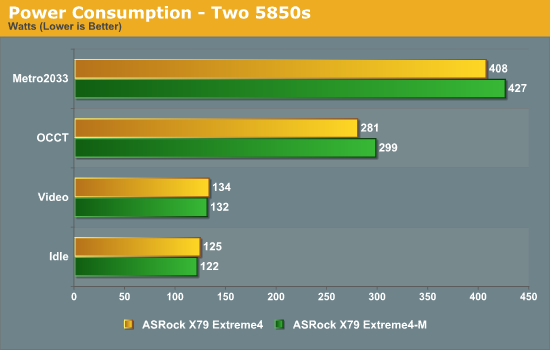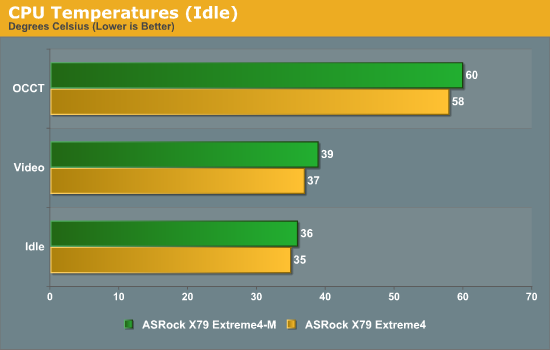ASRock X79 Extreme4-M and X79 Extreme4 Review – Sandy Bridge-E meets mATX
by Ian Cutress on December 9, 2011 12:00 PM EST- Posted in
- Motherboards
- ASRock
- X79
Test Setup
| Processor |
Intel Sandy Bridge-E i7-3960X 6 Cores, 12 Threads, 3.3 GHz (3.9 GHz Turbo) |
| Motherboards |
ASRock X79 Extreme4-M (mATX) ASRock X79 Extreme4 (ATX) |
| Cooling | Intel All-In-One Liquid Cooler, made by Asetek |
| Power Supply | Silverstone 1000W 80 PLUS Silver |
| Memory | G.Skill RipjawsZ DDR3-2133 9-11-9 28 4x4 GB Kit 1.65V |
| Memory Settings | XMP |
| Video Cards |
XFX HD 5850 1GB ECS GTX 580 1536MB |
| Video Drivers |
Catalyst 11.8 NVIDIA Drivers 285.62 |
| Hard Drive | Micron RealSSD C300 256GB |
| Optical Drive | LG GH22NS50 |
| Case | Open Test Bed - CoolerMaster Lab V1.0 |
| Operating System | Windows 7 64-bit |
| SATA Testing | Micron RealSSD C300 256GB |
| USB 2/3 Testing | Patriot 64GB SuperSonic USB 3.0 |
Comparison to Other Reviews
Where applicable, the results in this review are directly compared to the following chipsets and boards which we have reviewed previously.
Power Consumption
Power consumption was tested on the system as a whole with a wall meter connected to the power supply, while in a dual GPU configuration. This method allows us to compare the power management of the UEFI and the board to supply components with power under load, and includes typical PSU losses due to efficiency. These are the real world values that consumers may expect from a typical system (minus the monitor) using this motherboard.

In low power usage, the mATX uses less power, however in large usage scenarios, it uses more. This could be due to the GPU spacing - the Extreme4 has an extra slot gap between the GPUs, meaning there is some airflow, and the fans do not have to work as hard. That wouldn't really affect OCCT though, so I'm unsure where exactly the difference would be in this regard.
CPU Temperatures
With most users running boards on purely default BIOS settings, we are running at default settings for the CPU temperature tests. This is, in our outward view, an indication of how well (or how adventurous) the vendor has their BIOS configured on automatic settings. With a certain number of vendors not making CPU voltage, turbo voltage or LLC options configurable to the end user, which would directly affect power consumption and CPU temperatures at various usage levels, we find the test appropriate for the majority of cases. This does conflict somewhat with some vendors' methodology of providing a list of 'suggested' settings for reviewers to use. But unless those settings are being implemented automatically for the end user, all these settings do for us it attempt to skew the results, and thus provide an unbalanced 'out of the box' result list to the readers who will rely on those default settings to make a judgment. Ultimately, it all comes down to design – if a manufacturer has put thicker copper in its power plane, there is less resistance, and thus a higher voltage (and possibly temperature) at the CPU, but a higher overclockability, perhaps.

Overall CPU temperatures are within range for the two boards.










54 Comments
View All Comments
LauRoman - Friday, December 9, 2011 - link
Considering that inserting a pcie expansion card in a x16 (x8) slot could, on old chipsets/moterboards screw around with your 2/3/4 way sli/x-fire bandwith let's not kill it just yet.ckryan - Friday, December 9, 2011 - link
Intel chipsets don't have native PCI support anymore. You have to use a PCIe to PCI PLX chip on the motherboard to get the support. That means you're giving up PCIe bandwidth (probably not a big deal), but also PCI support is spotty. I have one SB board (an Intel DP67BG) that doesn't really work with any PCI soundcard (they've not been able to fix this with UEFI updates).
But at some point you just have to decide that you're going to not use PCI anymore, and people who refuse to replace their old busted sound card or bunk networking device are holding us all back. PCI is terrible, and I'd much have a PCIe x1 slot or no slot at all.
Wireless adapters are just as cheap in PCIe x1 as PCI, and gigabit ethernet is hamstrung by PCI as it's just not very fast. Soundcards are available from Asus and Creative in PCIe for cheap. I've got a Asus Essence STX PCIe which was more expensive, but why the hell would you buy the PCI version (which was more expensive) in 2011?
sylar365 - Friday, December 9, 2011 - link
My "old, busted" soundcard.http://www.newegg.com/Product/Product.aspx?Item=N8...
Got something that sounds better without bloatware available in PCIe? Besides, most audio chips currently being produced and placed on PCIe sound cards still require a PLX chip in order to convert from the PCI standard to use the PCIe form factor.
IMHO i wish they would kill PCI - AND THEN - make decent sound hardware available for PCIe slots. Admittedly there have been a couple of products in the past couple of months starting to emerge, but FFS it is time to go mainstream with some high quality PCIe sound hardware already!
JonnyDough - Friday, December 9, 2011 - link
Agreed. I have a Creative X-Fi myself, wish I'd gotten the HT Omega instead but it either wasn't out yet or I wasn't that informed on sound cards at the time. PCI slots are still very much needed. I have network cards both GB ethernet and wireless that utilize the old PCI slot too.yk - Friday, December 9, 2011 - link
What about HT | OMEGA eClaro 7.1 Channels 24-bit 192KHz PCI Express x1 Interface Sound Card?Siorus - Monday, December 12, 2011 - link
Useless. Only one socketed opamp and the surround channels look to be handled by JRC garbage (at least it's a step up from the tin-can-telephone-on-a-chip stuff that Creative dumps on people). I think one of the Asus Xonar PCI-E cards has swappable opamps for every channel but I'm not positive.Either way, until I can get that on a PCI-E card, I'll need to keep my PCI stuff.
twoBitBasher - Friday, December 9, 2011 - link
For now I'm still happy that Asrock is sticking with the PCI and the best part is that you can populate the whole board with dual slot graphics and still use the PCI! Most boards have already dumped PCI or implemented it so that if you go SLI or Xfire you are out of luck.Try to find decent cards with balanced 1/4" jack outputs and not go external!
Shadowmaster625 - Friday, December 9, 2011 - link
PCI is what makes a PC. There are hundreds of thousands of different PCI products, and most of them have no reason or need to be migrated to a different form factor.Chubblez - Friday, December 9, 2011 - link
The same thing has been said about ISA, EISA, and VLB. Where are they now?JonnyDough - Friday, December 9, 2011 - link
They are more dated. PCI came after, and is a variant of ISA. Things are shifting, but many would argue that the slot is still needed. Besides, its cheap as hell to add one. If anything needs to die its PS2.